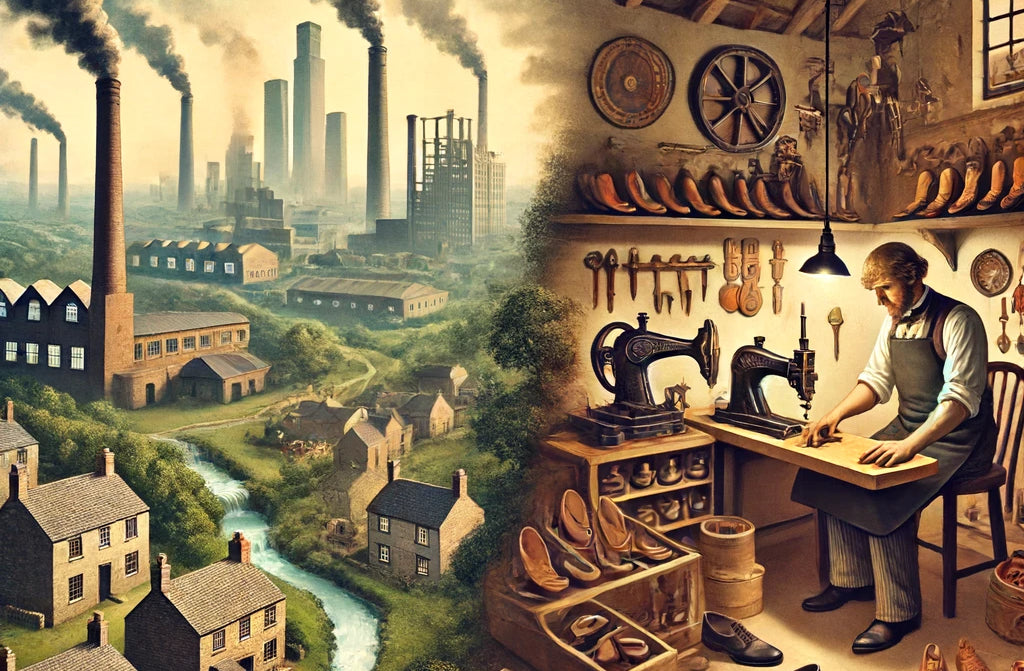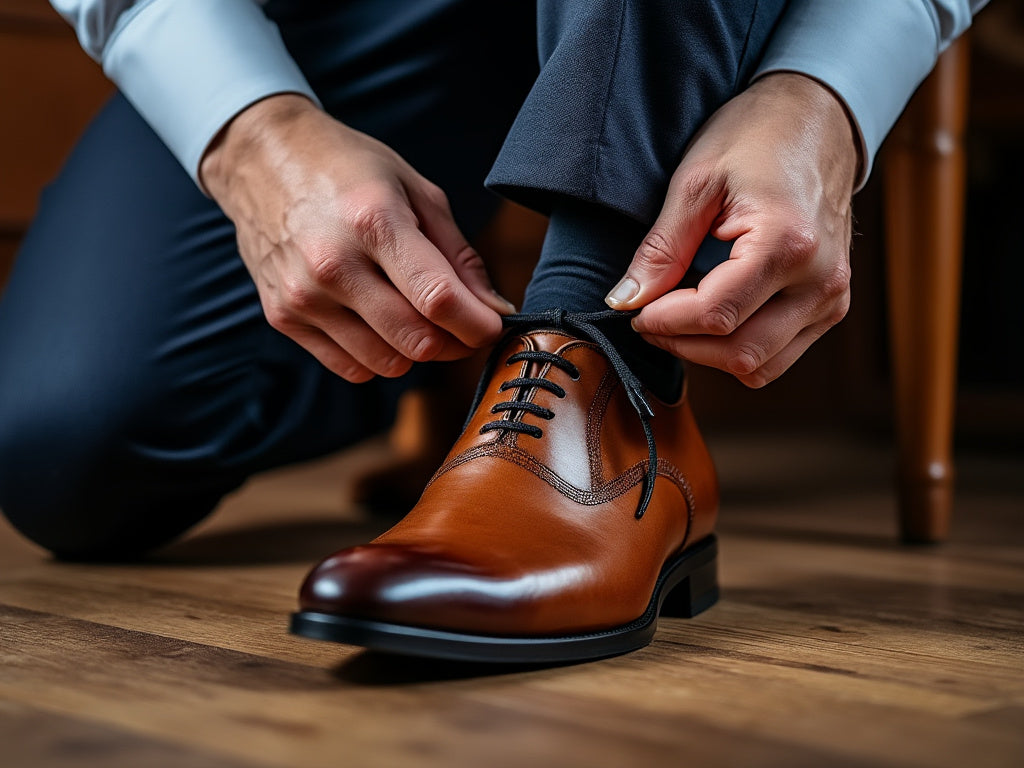
The Evolution of Shoemaking Apprenticeships: Tradition and Modernity
(If you're interested in being fitted from the comfort of your home for a pair of our bespoke shoes, explore our process and footwear collection at bondenoshoes.com)
Shoemaking is an ancient craft, deeply rooted in tradition and artisan skills. Over the centuries, the method of passing down these skills has primarily been through apprenticeships. These apprenticeships have evolved significantly, adapting to changes in society, technology, and industry needs. This blog post explores the history of traditional shoemaking apprenticeships and how they have transformed in the modern era.
The Origins of Shoemaking Apprenticeships
Shoemaking as a profession dates back to ancient civilizations, where skilled artisans created footwear to protect and adorn the feet. The earliest records of shoemaking can be traced to ancient Egypt, Greece, and Rome, where shoemakers were highly regarded craftsmen. The apprenticeship system began to take shape during the Middle Ages, a period marked by the rise of guilds.
Medieval Guilds and Apprenticeships
In medieval Europe, guilds played a crucial role in regulating trades and ensuring the quality of goods produced. The shoemakers' guild, like other craft guilds, established a structured apprenticeship system to train new craftsmen. Young apprentices, typically boys aged 12 to 14, were bound by contract to a master shoemaker. This contract, often lasting seven years, stipulated that the apprentice would live with the master, learn the trade, and perform various tasks in exchange for food, lodging, and training.
The apprenticeship process was rigorous and comprehensive. Apprentices began with basic tasks such as cleaning the workshop, fetching materials, and assisting with simple tasks. Over time, they learned the intricate skills of shoemaking, including cutting leather, stitching, shaping, and finishing. The master shoemaker closely supervised their work, ensuring that the apprentices adhered to the high standards set by the guild.
The Traditional Shoemaking Apprenticeship
The traditional shoemaking apprenticeship was more than just a means of learning a trade; it was an immersive experience that shaped the apprentice's entire lifestyle. The apprenticeship was not merely about acquiring technical skills but also about instilling values, work ethic, and pride in craftsmanship.
The Master-Apprentice Relationship
The relationship between the master and the apprentice was central to the traditional apprenticeship model. Masters were not just teachers; they were mentors, role models, and sometimes surrogate parents. They imparted knowledge through hands-on training, demonstrations, and direct supervision. This close-knit relationship ensured that the apprentice absorbed not only the technical skills but also the nuances of the craft, including problem-solving techniques, quality control, and customer relations.
Skills and Techniques
Traditional shoemaking involves a wide range of skills and techniques, each requiring precision and expertise. Apprentices learned to work with various materials such as leather, rubber, and fabric. They mastered the use of specialized tools like awls, lasts, hammers, and knives. Key techniques included pattern making, leather cutting, stitching, sole attaching, and polishing.
One of the most important aspects of traditional shoemaking was customization. Shoemakers often created bespoke shoes tailored to the exact measurements and preferences of individual customers. This level of personalization required apprentices to develop a keen eye for detail and an understanding of human anatomy.
Cultural and Social Aspects
Traditional shoemaking apprenticeships were deeply embedded in the cultural and social fabric of communities. In many cases, shoemaking families passed down the craft from generation to generation, with each new apprentice continuing the family legacy. Shoemakers often held a respected position in society, contributing to local economies and serving the needs of their communities.
The Decline of Traditional Apprenticeships
The Industrial Revolution brought significant changes to the shoemaking industry, leading to the decline of traditional apprenticeships. The advent of mass production and mechanization transformed shoemaking from a craft-based industry to a factory-based one.
Industrialization and Mechanization
The introduction of machines such as the sewing machine and the lasting machine revolutionized shoemaking. These machines increased production speed and reduced the need for skilled manual labor. As a result, many traditional shoemakers struggled to compete with factory-produced shoes that were cheaper and more readily available.
Shift to Factory Work
With the rise of factories, the demand for skilled shoemakers decreased. Many craftsmen and apprentices were forced to adapt to new roles as factory workers, where the focus shifted from craftsmanship to repetitive tasks on assembly lines. The factory system prioritized efficiency and uniformity over customization and artistry.
Impact on Apprenticeships
The decline of traditional shoemaking had a profound impact on apprenticeships. The structured, mentor-based apprenticeship system gave way to more informal, on-the-job training in factories. The focus on mass production meant that workers learned specific tasks rather than the holistic craft of shoemaking. The rich tradition of passing down skills through generations began to wane.
The Revival of Shoemaking Apprenticeships
In recent years, there has been a resurgence of interest in traditional crafts and artisanal skills, including shoemaking. This revival has led to the re-establishment of formal apprenticeships, blending traditional techniques with modern innovations.
Modern Artisanal Shoemakers
A growing number of artisanal shoemakers are dedicated to preserving the heritage of traditional shoemaking while incorporating contemporary design and technology. These modern craftsmen often operate small, independent workshops, focusing on high-quality, handcrafted shoes. They emphasize the importance of sustainability, ethical practices, and personalized service.
Structured Apprenticeship Programs
To support the revival of traditional shoemaking, various organizations and institutions have developed structured apprenticeship programs. These programs aim to provide comprehensive training, combining hands-on experience with theoretical knowledge. Apprentices learn the entire shoemaking process, from design and pattern making to cutting, stitching, and finishing.
One notable example is the apprenticeship program offered by the Worshipful Company of Cordwainers in London. This historic organization, dating back to the Middle Ages, continues to support the craft of shoemaking through scholarships, grants, and apprenticeships. Their program offers aspiring shoemakers the opportunity to train with experienced masters and gain valuable industry insights.
Integration of Technology
While modern apprenticeships emphasize traditional techniques, they also recognize the importance of integrating technology into the craft. CAD (Computer-Aided Design) software, 3D printing, and digital pattern making are increasingly being used to enhance precision and efficiency. Apprentices learn to balance the use of technology with the principles of traditional craftsmanship, ensuring that they are well-equipped for the future.
Collaborative Learning
Modern shoemaking apprenticeships often adopt a collaborative learning approach. Workshops and studios provide a communal environment where apprentices can learn from multiple mentors and peers. This collaborative atmosphere fosters creativity, innovation, and the exchange of ideas. Apprentices benefit from a diverse range of perspectives and experiences, enriching their learning journey.
Case Studies: Modern Shoemaking Apprenticeships
To illustrate the evolution of shoemaking apprenticeships, let's explore a few case studies of contemporary programs and their impact on the industry.
Stefano Bemer
Stefano Bemer, an Italian shoemaker renowned for his exquisite craftsmanship, has also established a comprehensive apprenticeship program. Their program combines traditional techniques with modern technology, providing apprentices with a well-rounded education. Trainees work alongside experienced artisans, learning the intricacies of shoemaking and the art of customization. The program also includes modules on business management and customer service, equipping apprentices with the skills needed to succeed in the industry. Stefano Bemer's commitment to apprenticeships reflects their dedication to preserving the heritage of Italian shoemaking while embracing innovation.
The New English Workshop
The New English Workshop is an organization dedicated to promoting traditional woodworking and shoemaking skills in the UK. Their apprenticeship program focuses on teaching traditional techniques, including hand-stitching, pattern making, and leatherworking. The program collaborates with experienced shoemakers and industry experts to provide apprentices with a comprehensive education. The New English Workshop emphasizes the importance of craftsmanship, sustainability, and ethical practices. Their program aims to inspire a new generation of artisans and ensure the continuation of traditional skills.
The Benefits of Modern Shoemaking Apprenticeships
Modern shoemaking apprenticeships offer numerous benefits for both apprentices and the industry as a whole. These programs provide aspiring shoemakers with valuable skills, industry knowledge, and the opportunity to learn from experienced mentors.
Skill Development
Apprenticeships offer a structured and immersive learning experience, enabling trainees to develop a wide range of skills. Apprentices learn the technical aspects of shoemaking, including pattern making, cutting, stitching, and finishing. They also acquire problem-solving abilities, attention to detail, and an understanding of materials and tools. These skills are essential for creating high-quality, bespoke shoes that meet the needs and preferences of individual customers.
Industry Insights
Apprenticeships provide trainees with valuable insights into the shoemaking industry. Apprentices learn about the history and heritage of the craft, as well as contemporary trends and innovations. They gain an understanding of the business aspects of shoemaking, including marketing, customer relations, and supply chain management. This holistic education equips apprentices with the knowledge and skills needed to succeed in a competitive industry.
Preservation of Craftsmanship
One of the most significant benefits of modern apprenticeships is the preservation of traditional craftsmanship. By passing down skills and techniques from one generation to the next, apprenticeships ensure that the heritage of shoemaking is not lost. Apprentices learn the principles of quality, precision, and artistry that define traditional shoemaking. This preservation of craftsmanship is essential for maintaining the unique value and appeal of bespoke shoes.
Innovation and Creativity
Modern apprenticeships encourage innovation and creativity in the craft of shoemaking. Apprentices are exposed to new technologies, materials, and design concepts, enabling them to push the boundaries of traditional techniques. The collaborative learning environment fosters the exchange of ideas and the exploration of new possibilities. This blend of tradition and innovation ensures that the craft of shoemaking continues to evolve and adapt to changing customer needs and market trends.
Challenges and Opportunities
While modern shoemaking apprenticeships offer numerous benefits, they also face challenges. The industry must address these challenges to ensure the continued success and growth of apprenticeship programs.
Funding and Support
Securing funding and support for apprenticeship programs can be challenging. Governments, industry organizations, and private enterprises must recognize the value of apprenticeships and invest in their development. Financial support, grants, and scholarships can help aspiring shoemakers access training opportunities and ensure the sustainability of apprenticeship programs.
Awareness and Accessibility
Raising awareness about the value of shoemaking apprenticeships is essential. Many young people may not be aware of the opportunities available in the craft of shoemaking. Outreach programs, partnerships with educational institutions, and industry events can help promote apprenticeships and attract new talent. Making apprenticeship programs accessible to diverse populations is also crucial for fostering inclusivity and ensuring a vibrant and diverse industry.
Balancing Tradition and Innovation
Modern apprenticeships must strike a balance between preserving traditional techniques and embracing innovation. Apprentices should learn the principles of traditional craftsmanship while also gaining exposure to new technologies and design concepts. This balance ensures that the craft of shoemaking remains relevant and appealing to contemporary customers.
Conclusion
Shoemaking apprenticeships have a rich history, deeply rooted in tradition and craftsmanship. While the advent of industrialization brought significant changes to the industry, the revival of artisanal shoemaking has rekindled interest in traditional apprenticeships. Modern shoemaking apprenticeships blend the principles of traditional craftsmanship with contemporary innovations, ensuring the preservation and evolution of the craft.
These apprenticeships offer aspiring shoemakers valuable skills, industry insights, and the opportunity to learn from experienced mentors. They play a crucial role in preserving the heritage of shoemaking, fostering innovation, and ensuring the continued appeal of bespoke shoes. By addressing challenges and investing in the development of apprenticeship programs, the industry can ensure a vibrant and sustainable future for the craft of shoemaking.
In conclusion, shoemaking apprenticeships represent a vital bridge between tradition and modernity. They embody the values of quality, precision, and artistry that define the craft of shoemaking. As the industry continues to evolve, apprenticeships will remain essential in nurturing the next generation of master shoemakers and ensuring the enduring legacy of this timeless craft.













Leave a comment
This site is protected by hCaptcha and the hCaptcha Privacy Policy and Terms of Service apply.